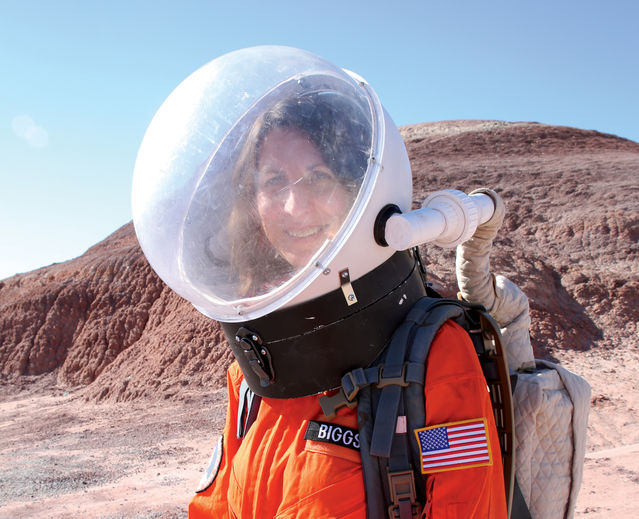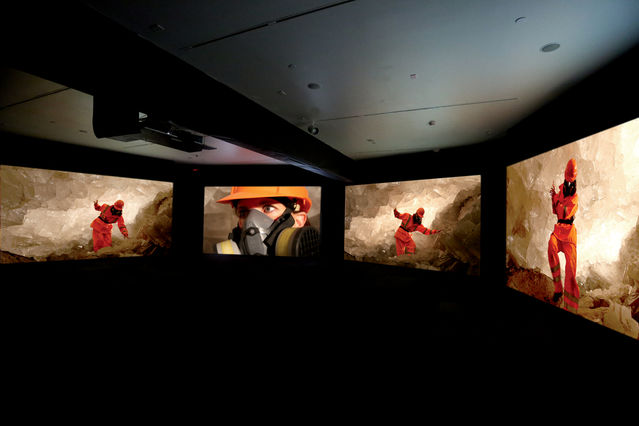Wide Angle
Video artist Janet Biggs doesn't stay in her comfort zone for long.
By Matt Huston published November 6, 2018 - last reviewed on January 1, 2019

She leads viewers deep underground, plants them in a wind-beaten Chinese desert, and whisks them to labs where scientific instruments pop and hum. She's trained her camera on a simmering volcanic landscape that mirrors a climate of conflict—and was held captive along the way. For more than 20 years, 2018 Guggenheim Fellow Janet Biggs has created video installations that plunge us into the unfamiliar. There, we meet bold, often solitary figures—laborers, athletes, musicians, and occasionally the artist herself.
Do you consider yourself an explorer?
I'm not sure I would define myself that way. I'm really drawn to the extreme, whether it's a landscape or a situation. I want to challenge myself; it makes me a better artist. I think it probably makes me a better human. At the same time, I'm a tourist in extreme situations: I'm witnessing something, but I get to go home. And yet other people thrive in such circumstances, and it defines who they are.
How does video help portray people differently than photography?
It's more akin to how we experience the world—through movement. Photographs are frozen moments, so they tell a really specific and subjective story. Not that my video isn't subjective. I'm relatively skilled in becoming a fly on the wall, but when I filmed in the Afar Triangle in East Africa, I could never become invisible. The video shows that; I'm stared down countless times, and rightly so, given the unstable situation there. So the moving image has the ability to reveal not only more about the subject but also more about the person behind the camera.
What distinguishes your installations from documentaries?
My projects start from a documentarian's perspective: I go out and I gather information. Generally, my pieces are between 5 and 10 minutes, and that's a month of filming, so there are a lot of outtakes. But rather than narrowing down the information, I want it to be complicated and expansive. Sometimes I'll do that with juxtapositions that seem, perhaps, to make sense—perhaps not. Whatever your history is, you'll have a different idea about why I combined two disparate images.
Why do these unexpected combinations appeal to you?
There is a freedom in being able to throw anything together. It was clear to me that the motorcyclist Leslie Porterfield—who holds three world records in speed—had to coexist with the Addicts Rehabilitation Center Gospel Choir. The focus on being the best makes many elite athletes more of who they are, but they also kind of disappear from the social construct. Presence is combined with loss or disappearance, and addiction does the same thing.
One piece cuts from a pit crew to a classical duet, changing how we see both.
I started filming NASCAR because it was a sport I didn't get, and so much of our country absolutely gets it, so I was curious. I watched the pit crews and they were so beautiful. It was ballet; there was no other way to see it. So in my mind, to pair it with an opera singer and violinist made total sense.

Your work seems to treat freedom and isolation as two sides of the same coin.
Most things that people strive for are much more complicated than one word. One of my videos shows a muscled, beautiful horse and a young autistic girl on ice skates. At first, you associate the horse with freedom and power and the girl with limitations. But as you watch, you see that the girl on skates is absolutely free, while the horse is kept on a tight line. For a later project, I climbed a glacier, found a hole, and rappelled down into it. There were moments that were full of wonder and others that were terrifying.
You take quite a few risks for your art.
Sometimes they fail and get me in big trouble. But it's new information. I was once held for a couple of days while traveling in Djibouti and had to negotiate to be released, which is a skill I didn't have before. There are factions known for kidnapping in that region, but luckily my experience was not with them. It was with two men I had hired as a guide and a driver—which is insulting. I was just being shaken down for more money. While I wouldn't want to go through it again—there were pointy things banged about and locked doors and isolation—I was probably most insulted by how little they asked for.
How does using multiple screens, as you often do, add to the presentation?
If you're surrounded by screens and you can't see them all at once, you become an active participant. How you navigate the installation changes its meaning. It's also immersive. A piece I filmed inside a volcano in Indonesia has five screens and sounds like it did when I was in the caldera, hovering above a sulfuric acid lake. The first time I showed it, someone asked, "How did you get the smell in the room?"
The inspiration for some recent projects seems closer to home.
I have too much experience with Alzheimer's—through my grandfather, an aunt, and now my mother. For one piece that addressed this, I filmed myself in the crystal cavern in the Merkers Cave in Germany. My grandfather collected gems and crystals, and even when he could no longer identify family members and friends, he could still tell you specific details about his collection. So I went on a kind of metaphoric journey to place myself inside one of his moments of presence.
Are your projects like experiments?
Yes, in that information usually comes from perceived failures. I do heavy research before going to a region. Then I get there and I realize I have misunderstood everything. But it opens me up to learn what is there.
